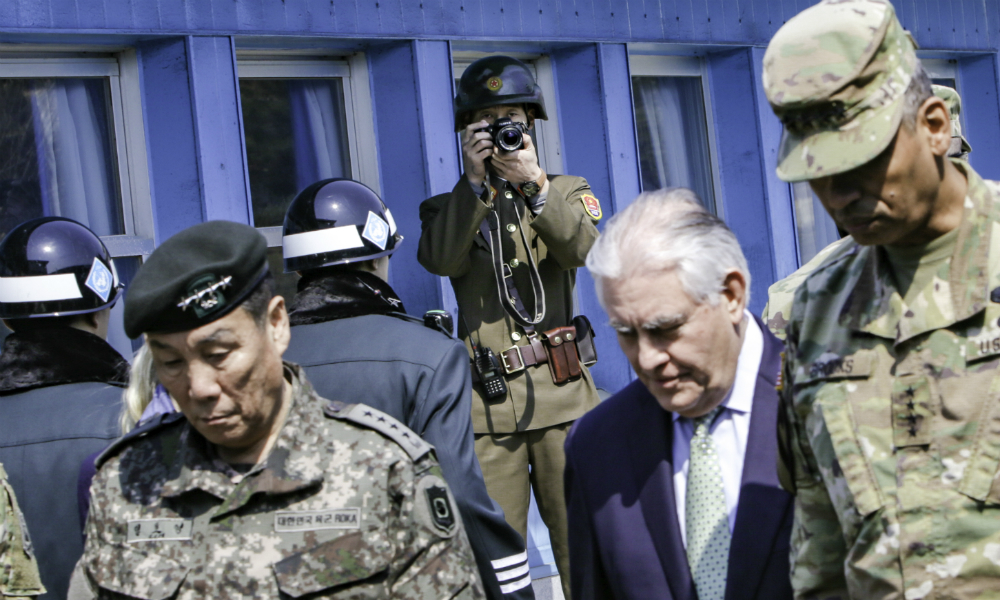You know there’s a national security problem brewing when in the space of seven weeks, the chairman of the Joint Chiefs opines on the widespread challenges North Korea presents, followed closely by visits to South Korea from the secretaries of defense and state.
In a similar effort to come to grips with some of the larger strategic issues at play, I recently concluded an intense, week-long visit to the Korean theater of operations, including the combined warfighting command there (Combined Forces Command/United Nations Command/US Forces Korea; CFC/UNC/USFK). What follows is a list of experience-based takeaways that may be of practical interest and potential use by those well beyond the confines of the Korean Peninsula—things to consider as we slide closer to conflict.
- We are in a “turn.” In racecar driving, there’s an old saying: “you win in the turns.” And we’re in just such a fundamental shift in the environment. North Korean behavior and capabilities are changing in dangerous ways clearly perceptible from even the recent past. South Korea has thrown out an administration. The American secretary of state has declared the era of “strategic patience” is over, and, Americans of all political persuasions agree on North Korea as the nation’s top enemy (perhaps the only thing the two parties agree on). Russians seem relatively amenable to the new American administration, so at least one key international constituency that will matter in any potential diplomatic deal might be willing to support US efforts. If Lincoln was right that “public sentiment is everything,” then these data points suggest we are at a moment of strategic opportunity.
- Military options are bad, and getting worse. Forcible removal of the North Korean nuclear threat “left of boom” is difficult, uncertain, or risks international condemnation over a close-call preemptive strike. “Right of boom” defensive measures are costly and reliant on immature technology. Things are pretty tough as it stands, which suggests other tools of national coercion ought to come first—yet, like wine’s inverse, the North Korean threat worsens with age, and so everyone acknowledges down-the-line use of force will be costlier. With South Korea, we’re stuck in a hard place.
- People are the dominant terrain along the world economy’s worst fault line. South Korea’s population density is eleven times that of Afghanistan; North Korea is three times more densely populated than Iraq and four times more than Afghanistan (and this does not account for its famously mountainous topography). So a new Korean war would be much more a war among the people than America’s most recent conflicts. The DMZ also sits at the intersection of interests of four great powers in the United States, China, Japan, and Russia—and so an explosion of violence there would mean an economic earthquake that would shatter the financial Richter scale and swell outward (e.g., Australia’s four top trading partners are China, the United States, Japan, and South Korea; New Zealand’s top partner is Australia; and so on). The stakes are extremely high in both blood and treasure.
- The strategic threat is characterized by known enemy capabilities and unknown enemy intent. For deterrent purposes, North Korea generally announces its capabilities to the world, and so we have a reasonably strong sense of the state of their weapons technology. The harder part is gauging intent; the human dynamics are more difficult. The trick is to solve what we can solve now as technical issues (i.e. missile defense), yet, never to the exclusion of the second (human) part of the problem, because while one opens the theater’s door, the other dictates how successful we’ll be on entry.
- North Korea has the advantage of will and speed; the US–South Korea alliance has size and strength on its side. North Korea generally has the first mover advantage, the power of one, and the will to survive—a position that provides distinct advantages. The United States and South Korea have a much larger and stronger alliance, more powerful weapons and instruments, and international support and legitimacy. This weight often, on balance, wins, but such success is far from guaranteed in Korea.
- North Korea consistently seeks a rational end; the US–South Korean alliance inconsistently seeks multiple ends. Democracy is messy and different domestic constituencies drive different objectives at different times (as one person on this trip put it, there’s an “amnesia” with each new administration; another said “South Korean foreign policy is consistently inconsistent.”). Oppositely, a dictatorship’s sole constituency is the dictator, who, in North Korea’s case, has a laser focus on survival.
- War in North Korea will be messy and slow, like eating budae-jjigae with a knife. North Korean ideology, physics, and geography all conspire to ensure any war and subsequent rebuilding effort will be measured in years and decades, not months and days.
- Homeland defense starts in Seoul. Defending CFC/UNC/USFK’s rear supply lines (i.e., sea lines of communication, Japan, Hawaii, etc.) and the US homeland are largely the same challenge—in unequal measure, advancements in North Korean long-range strike should ultimately hold both at risk, with their estimated ability to deliver a nuclear-capable intercontinental ballistic missile by 2020. This means the CFC/UNC/USFK commander has powerful combatant command allies that share his concerns: the USPACOM and the USNORTHCOM commanders (for geographic reasons), the USSTRATCOM commander (for strategic threats), the USTRANSCOM commander (for supply line threats), and for all things related to counter weapons of mass destruction missions, the USSOCOM commander. All these commands bear some responsibility for the North Korean deep threat. As such, Department of Defense-wide help should be relatively less difficult to attain in terms of investment and support.
- This is a slow-motion Cuban Missile Crisis (and to some, we’re the Soviets). A distant country inputs a military capability which is subsequently deemed destabilizing to a mainland nation—in 1962 it was 200+ Soviet nukes to Cuba (ninety miles from the United States); in 2017, it’s a US THAAD battery to South Korea (200-ish miles from China). The solution, then, was to trade near-term tactical weapons withdrawal for longer-term, extra-regional weapons withdrawal. Could a similar logic be applied today? If the next South Korean administration is amenable to a deal to remove the THAAD battery, what would we want as a concession-in-kind for removal of this capability?
- Think global, act local (because this as much about the United States and China as it is about North and South Korea). While the Koreas are certainly not proxies in the traditional (pejorative) sense, today’s conflict on the Peninsula is playing out against a much wider strategic competition between the United States and China in the Indo-Asia Pacific (and, indeed, the world). Developments in Korea will be key to shaping this larger contest, and we may have to give a little now to get more in the long run. For example, we may achieve a degree of success in Korea that could prove detrimental to our broader interests vis-à-vis the Chinese. Alternatively, we might give some in Korea. Consider a hypothetical question: If we could severely reduce the North Korean nuclear threat in exchange for a severely reduced US presence on the Korean Peninsula—would we take that deal? Nearly everything’s a tradeoff.
In sum, what does all this mean now, while we’re “left of boom”? Considering the panoply of issues above, we should acknowledge there is no silver bullet that can kill all the problems that come with the potentially devastating, occasionally violent, moon-howling, North Korea werewolf. However, there is silver buckshot available that we could fire at the proximate challenges North Korea’s monstrous provocations present. In the final analysis, we ought to develop a military strategy designed to enforce an internationally backed, coherent, consistent system of response that supports and underpins an aggressive diplomatic effort, featuring these defining characteristics:
- Avoids but doesn’t fear war and is willing to risk one for diplomatic breakthroughs
- Communicates clearly through deliberate, calibrated, tailored uses of force
- Regains initiative; channels North Korean actions toward US–South Korean alliance decision superiority
- “Fails forward” so that a step back in one direction means two forward in another
- Maintains alliance cohesion while further isolating North Korea from support
- Urgently invests in ready-now denial technologies
- Rapidly develops preparedness and human capital for Korean theater-specific skills
As with most national security challenges, the aim is not to get everything “right,” but instead to generally get things more right than the enemy. By doing these listed items well, and minding the issues enumerated above, we may just find that the next time the JCS chairman assesses the North Korea threat or the secretaries of defense and state find themselves in Seoul—it will be for slightly sunnier reasons.
Image credit: Sgt. 1st Class Sean K. Harp, US Army



I have this unorthodox idea that it would be awesome to hear your comments. The final goal is that all part involved (minus NK current government) would consider the outcome a win. With that in mind, what if U.S. and China act on the ground to eliminate the NK government after certain assurances were given?
Korea unifies (victory for South Korea and general Koreans), integrates any member of NK that is not directly connected with the ruling family declares itself neutral, making deals with both US and China. US claims a victory over a threat, retreat THAAD and troops from South Korea (no more threat). China claims victory (no more U.S. troops or missiles near them) and resume business with an unified neutral Korea. The nukes are either destroyed or captured (China?).
I have wondered the same thing – whether there is a cooperative grand bargain possible with China to resolve this issue:
– China facilitates the removal of the current NK regime (something that they are best positioned to accomplish by covert means while minimizing bloodshed);
– US and China cooperate to neutralize and eliminate the NK nuclear program;
– China assumes a temporary peacekeeping and non-proliferation role in the North, until a unification process can be completed;
– US and China facilitate the unification of Korea as a neutral democracy;
– US removes our forces from the Korea peninsula (something we would prefer to do anyway), and US and China agree to the permanent removal of all foreign military forces from a unified Korea.
I would think that this outcome would be attractive to the Chinese government and to the Koreans (it certainly would accomplish the strategic objective that the US seeks), and thus all parties would be committed to its success. The only question is if the Chinese actually could accomplish the removal of the NK regime with minimal violence.
“Avoids but doesn’t fear war and is willing to risk one for diplomatic breakthroughs”
I feel this is an unwise pillar generally and in this context in particular. I think I know what the author means – that we should have confidence in our strength and against DPRK in particular, and we should be willing to use it. But as leaders entrusted with the lives of our soldiers, and in this context the lives of many tens of thousands of South Korean civilians, we ought to avoid and fear war. And be unwilling to risk it for anything except the most vital national aims. Especially now that DPRK has nuclear weapons we simply must not trigger war.
If they start it, or China does elsewhere, then so be it. But absent those possibilities, our only good option in Korea is to wait them out. One inevitable but possibly distant day, the regime will either collapse or peacefully reform. We just have to wait.